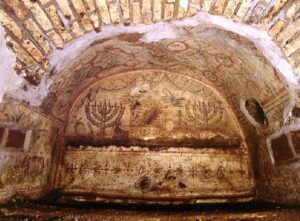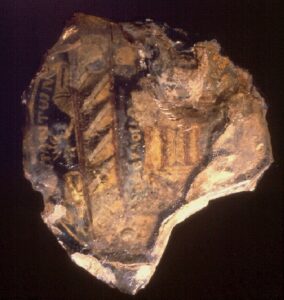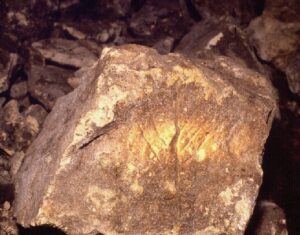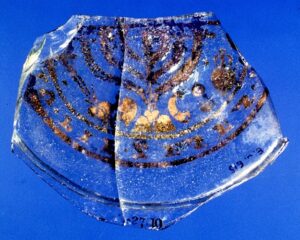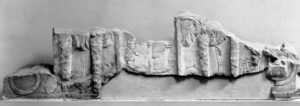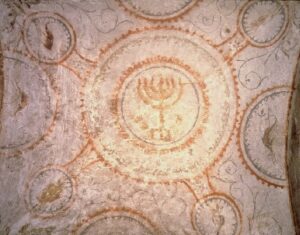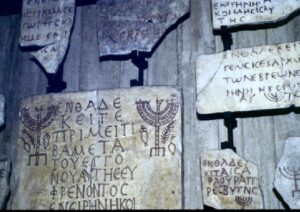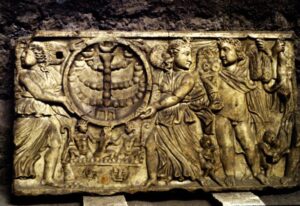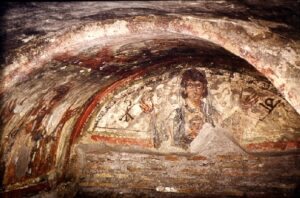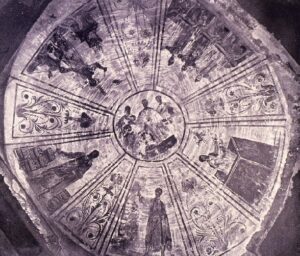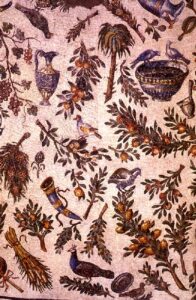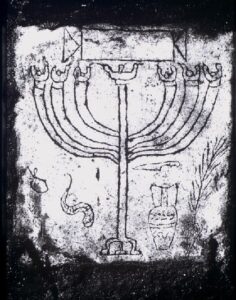COSMIC SCENES AND SYMBOLS. Excerpt from: Estelle Shohet Brettman, Vaults of Memory: The Roman Jewish Catacombs and their Context in the Ancient Mediterranean World, with Amy K. Hirschfeld, Florence Wolsky, & Jessica Dello Russo. Boston: International Catacomb Society, 1991-2017 (rev. 2024).
The Roman Empire fell heir to the unification of the East and West, which emerged from Alexander's conquests, and thus had provided an incubating medium for the development and fermentation of sects with cosmic ideologies. The interchange and interaction of many philosophical and religious concepts, in addition to the pervasive Hellenistic koine (shared elements of culture, including language), played a major role in influencing the established religions and in breeding new mystical sects. The subject matter with which we are dealing cannot pretend to represent more than a microcosmic illustration of the total intermingling processes that had, and would, shape history, religions, philosophies, and artistic expression for centuries to come. All these parallels in the funerary art of the Roman Empire lead one to conclude that artistic expression for ritual purpose draws upon the language of its period and then adapts the vocabulary to its own needs and precepts. The basic symbols have persisted in one form or another through the ages as have humankind’s basic concerns.
Seven was a mystical number among the ancients. The menorah, which had seven branches, as did many representations of Trees of Life, was a Jewish sacred object as early as the time of Moses (Exodus 25:32,35; Numbers 8:1-3). Its blazing seven lamps may have symbolized the ancient cosmos, thus suggesting the eyes of the Lord "which run to and from through the whole earth" (Zechariah 4:10) or the "seven Spirits of God sent forth into all the earth" (Revelation 5:6).
Images of the menorah, the Torah shrine, and perhaps also the temple, were depicted in catacomb frescoes and artifacts. Their presence on earth (Exodus 25:21-22; Numbers 10:35-36; 1 Chronicles 28:2; Psalms 132:8; Isiah 6:1) as well as their heavenly settings (2 Corinthians 5:1; Revelation 11:19) indicate the radiant presence of the Supreme Being, bringing hope of salvation and redemption for both ancient Israel and the deceased. Because the seven-branched lamp-stand still signified deliverance for early Christians (Revelation 1:12-13), its representation has, on occasion, been found with Christian motifs. The seven lamp-stands symbolize the seven churches of Asia: "and there were seven lamps of fire burning before the throne, which are the seven spirits of God" (Revelation 4:5).
Representations of the cross also appear in the catacombs. The cross not only represented the four cardinal points of the universe from which came the life-giving winds and rains, but was talismanic for many peoples. The crux gammata, or swastika, was adopted by the Eastern religions and depicted in pagan, Jewish and Christian cemeteries. The crux commissa, in the shape of the Greek letter tau, which may relate to the Hebrew tav, the mark that saved the first-born of the Israelites in Egypt (Exodus 12:7, 12:22-23), is often pictured in Christian art in the Old Testament scenes of deliverance. Also the crux ansata, the Egyptian ankh, continued to be the sign for life in Coptic art. The cross-like anchor and trident, the Latin and Greek crosses and the Christogram were all standard emblems of Christianity by the fourth century. In addition, the cross was a metaphor for the tree which was related to the dying and saving God who was resurrected with the budding of its spring leaves. Thus, both cosmic symbols, the menorah and the cross, had origins in the Tree of Life and signified the presence of a Lord who offered redemption and immortality. "To him that overcometh will I give to eat of the tree of life which is in the midst of the paradise of God" (Revelation 2:7).
Fig. 1. Cosmic Illumination: The Lamp-stand and the Book. The now fragmentary inscription for Salutia. From the Monteverde catacomb.
"Thy word is a lamp unto my feet and a light unto my path" (Palm 119:105). "A law will go forth from me and my justice for a light on the people" (Isaiah 51.45).
Fig. 2. Torah Shrine. In the upper register, a baldachin-like shrine containing six Torah scrolls is guarded by lions of Judah. In the lower register, two flaming menorahs flank a lulav among such ritual objects as shofars, an amphora, and an ethrog. The Latin transliteration of the Greek inscription above this scene reads: ANASTASI PIE ZESES, a provocative exhortation. The Greek word anastasis means "rising up" or "resurrection." Pie, zeses, which means "drink, live," a formula also found on gold glass from the Christian catacombs, is analogous to the Hebrew “le Hayim”, a toast to life offered by the Jews on the festal drinking of wine. Gold glass. Apparently the bottom of a drinking vessel, used as a tomb marker and probably from the Jewish catacombs of Rome, as are the other gold glass fragments bearing Jewish motifs.
Images of the scrolls and Ark of the Torah in the catacombs are not surprising: "He who has acquired for himself words of the Torah, has acquired life in the corning world"--Pharasaic sage Hillel (M. Avot, 2,8). One tombstone reads: “Here lies Hilaros, Archon from the Synagogue of the Volumnesians, who lived 35 years. In peace his sleep. His memory [for a blessing?].” An aron flanked by a shofar and lulav on the left and an amphora on the right are incised above two round objects which could represent matzot or the ends of scrolls. The Torah Shrine, here with scrolls, may have been Hilaros' concept of the "eternal home”. The Ark also appears flanked by two towering menorahs on an inscription marked EULOGIA. The Greek word eulogia could either be a proper name or mean "benediction."
Fig. 3. Celestial Torah Shrine. Two blazing menorahs flank a now damaged, open Torah Shrine, with lulav, pomegranate, and two-handled vessel on each side of the menorah on the left, while on the right there is a shofar, knife (possibly for circumcision), and ethrog with the menorah. Clouds partially obscure the sun and moon to the left and right, and a star shines above. "Thy sun shall no more go down; neither shall thy moon withdraw itself for the Lord shall be thine everlasting light...and the days of thy mourning shall be ended" (Isa. 60:20). Rosette-studded curtains are drawn back to reveal this heavenly scene. Lunette painting in an arcosolium near the frescoed cubiculum in the upper catacomb of Villa Torlonia, Rome.
Fig. 4. Chalice with Cross. Curtains are opened to reveal a cross within a gabled shrine in starry heavens. Two angels draw near with books(?) (Rev. 1:2, 8-10). Glass chalice probably used to contain Eucharistic wine. Syro-Palestinian. Sixth century CE.
The Crux Gammata
The crux gammata or gammadion was an import from the East and has been used over the millennia as an emblem to bring good fortune. Its representations can be found in pagan, Christian, and Jewish cemeteries in Rome.
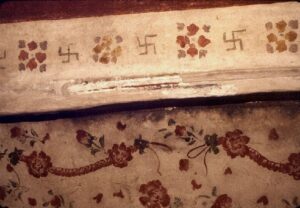
Fig. 5. DAPICS n. 1323 (also nn. 0604-5).
Fig. 5. Swastikas alternating with rosettes. Painted over the arcosolium on the right wall of the mausoleum of M. Clodius Hermes, Catacombs of St. Sebastian, Rome.
Fig. 6. Three swastikas with a crown painted in the niche of the sacellum decimum primum over an inverted anchor. Christian catacomb of Via Anapo in Rome.
Fig. 7. Swastika with ivy leaf on the right end of the epitaph of Pancharios, who was buried "honorably" in the catacombs of the Villa Torlonia.
Fig. 8. A Holy Precinct. De Rossi's 1884 reproduction of this fragment of gold glass was made from a chromolithograph plate. De Rossi obtained this view by examining both faces of the fragment after cleaning the originally "opaque" find. The Greek inscription, if intact, would probably have read "House of Peace. Take blessing with all of your family." While this structure has been identified variously as a tomb, Torah shrine, or Temple, its discoverer, De Rossi, like Marucchi and later Frey, preferred to interpret it as a representation of the First Temple. Thus the two isolated flanking columns which appear to float in the holy precinct were determined to be an adaptation of the famed pillars, Jachin and Boaz, in Solomon's Temple (I Kings 7:15, 21). Other scholars interpret the image as Herod's Temple.[1]
A composite perspective reveals an aedicula lavishly embellished with gold and featuring doors which seem to consist of folded leaves; a menorah graces the triangular pediment. Centered in a courtyard, it is enclosed on three sides by a colonnade, which is abutted on the right, as it must have been on the missing left side, by two schematized buildings, perhaps entrance gates, in front of palm trees. A gold table, or tables, behind a trellis-like barrier confining the anterior section of the sacred enclosure, bears a flaming gold menorah flanked by gold vessels. A splendorous vignette which is reminiscent of biblical passages describing Solomon's Temple (I Kings 6, 7). In addition to this sumptuous array, the cult objects of the Feast of Tabernacles stress the ritual character of this scene. The pediment of the four-stepped edifice rests on four columns and is graced by a menorah. This rare Jewish example of gold glass, dating from the second half of the third or early fourth century, was discovered about 1882 in the Christian catacomb of SS. Marcellino e Pietro close to the Jewish cemetery of Via Labicana in Rome.
Fig. 9. Graffito of a Menorah. This graffito, now fragmented, is still another example of a Jewish symbol found in a Christian catacomb. The author observed this incised treelike menorah in the catacombs of SS Marcellino e Pietro, Rome.
Fig. 10. Hope for the Restoration of the Temple. Obverse of a silver tetradrachm (shekel), probably minted in Palestine during the third year (134-135 CE) of the Bar Kokhba war shows a tetrastyle facade possibly of the Temple in Jerusalem with perhaps the Aron in the center and a symbolic star above. The inscription reads: Shimon (Simon). On the reverse, the appropriate cult objects, the lulav and ethrog are stamped along with the inscription le-herut Yerushalem, "for the freedom of Jerusalem.”[2] The scene, ever symbolic of renewal, connotes hope for the redemption of the Holy Land and offers such hope for the deceased.
Fig. 11. Treelike Menorah. This crude graffito, observed in a Hellenistic through Byzantine cemetery in Sicily (dating from the second to first centuries B. C.), recalls the probable origins of the menorah in the Tree of Life. The author stumbled on the stone in a cemetery in Palazzolo Acreide, Sicily.
Fig. 12. Foliate Memorah. An arboreal menorah spreads its branches over the traditional cult symbols. Vegetal and circular objects (the one marked with an x may represent a loaf of bread) float in the field. The popular toast: "Drink, life" again Greek transliterated into Latin, are the only words distinguishable in the epigraphy encircling this fragment of gold glass which, like most of these pieces, was probably the base of a vessel with original provenance, possibly the Catacomb of Monteverde in Rome.
Fig. 13. The Menorah among its Forebears. The menorah is carved amidst a grove of palm trees interspersed with an ethrog, lulavs or palm branches, possible whirling rosettes, and other unidentified objects, one of which is circular. This figuration also resembles the Egyptian hieroglyph for eternity but without the horizontal base line, and possibly represents a crown. The scene evokes the biblical description of the lamp-stand with seven lamps between two olive trees (Zech. 4:2, 3) although the number and the species of trees differ. Fragment of a marble sarcophagus from the catacombs of Vigna Randanini in Rome, 3d-4th c. CE.
Fig. 14. The menorah was the preeminent Jewish symbol, especially in Roman times. The seven-branched lamp-stand, the menorah, closely identified with the Jews since ancient times, takes pride of place in the center of the vault. Stylized grapevines, popular in pagan and Christian funerary art, enclose a shofar (horn) and ethrogim (citrons)--all Jewish ritual objects--as they sprout from the corners of a heavenly arbor. Four dolphins entwined around tridents, symbols which also grace Christian and pagan cemeterial contexts, are circumscribed in the interspersed painted lunettes. vault painting. Decorated (cubiculum), upper catacomb of the Jewish catacombs under the Villa Torlonia.
Fig. 15. Ritual Symbols Frame the Epitaph of a Grandmother and Grandson. "Here lies Primitiva with her grandson Euphrenon (Euphrainon]. In peace their sleep." Primitiva bore a Latin name while her grandson's name was Greek. The finely incised familiar Jewish cult symbols, the ethrog, lulav, menorah, and amphora, a narrow-necked vessel with two handles, create a harmonious, symmetrical setting for the inscription. From the Monteverde catacomb in Rome, now in the Vatican Museums.
Fig. 16. Sarcophagus with Jewish Emblems. A seven-branched lamp-stand is flanked by a shofar, ethrog, and an object on the right, termed a root or mandrake by some scholars. Perhaps it could also represent an abbreviated lulav. Photographed in the Villa Torlonia in 1919, whereabouts unknown today.
Fig. 17. Sarcophagus Fragment with a Medley of Symbols. On this fragment of a marble sarcophagus, the menorah, an ancient Jewish symbol, is enclosed in a roundel which is supported by two winged Victories. This was adopted from a Roman composition in which the medallion usually contained portraits of the deceased. Christian funerary art transformed the Victories into angels, bearing either Christian symbols or portraits. The vintage scene below and the two "Genii of the Seasons", Autumn holding two geese and Winter holding a boar, were also motifs which occurred in all three iconographies. Find spot not known: on display in the Terme Museum, Rome.
Fig. 18. Child's Sarcophagus. On this child's sarcophagus, winged angels hold a wreath with the monogram of Christ which here replaces the customary portrait of the deceased. Late fourth to early fifth century. Sarcophagus from O Sariguzel.
Fig. 19. Mother and Child. A fresco in which a pair of Constantinian monograms, later known as Christograms face each other and flank the elegantly arrayed, woman, in orant attitude, with a child--an age-old theme represented in art as early as Old Kingdom Egypt in figurations of Isis and Horus. The scene is rendered in the robust, frontal, compact style and has been variously interpreted as a portrayal of the deceased with her child or as the Madonna and Child. Lunette painting, arcosolium of an early fourth century chapel. Cimitero Maggiore, Rome.
SHARED SYMBOLS
Themes of the miracles of the Old Testament were borrowed by the early Christians, and motifs from earlier religions and myths were adapted by both faiths to invoke salvation and immortality, according to the beliefs of the deceased.
Fig. 20. "Ecumenical Wheel". A simultaneous depiction of Old and New Testament themes. Painted vault of a cubiculum near the crypt of the Fornai (bakers), catacomb of Domitilla, Rome.
Fig. 21. Bottom of a bowl. Probably from the Christian catacombs of Rome. Late third to early fourth century.
Fig. 22. "Inhabited" Vegetal Interlace. An assemblage of ritual symbols--shofar-like horn, palm tree, birds perched on a bowl, libation pitcher, plus other familiar motifs--all pertinent to religious iconographies of the period. C. mid-fourth century. Vault. Ambulatory of Sta. Costanza, Rome.
Fig. 23. Immortal Sacred Symbols. A ritual vessel, palm branches, and a horn--cult objects of ancient Crete were carved on this green jasper Minoan gem more than two and one half millennia earlier than the mosaic above.
Fig. 24. Holy Light upon the Name of the Deceased. On an elegantly carved marble from the Vigna Randanini, a menorah illuminated the tabula ansata above, which framed a now faded three-line epitaph in red minium. The familiar cult objects--the ethrog, shofar, vessel, lulav, and less frequent circumcision knife--surround the sacred lamp-stand; on the far left is incised plant form, which might be a stunted lulav or mandrake.
[1] G. B. de Rossi, “Verre représentant le temple de Jérusalem," in Archives de l’Orient Latin II, (Paris, 1884), pp. 439-455. Estelle Brettman adds: “In pursuit of the study of Jewish artefacts and symbols yet to be disclosed in Christian catacombs, I was particularly provoked by De Rossi's late nineteenth century unearthing of this fragment of Jewish gold glass in a Christian catacomb.”
[2] Y. Meshorer, Ancient Jewish Coinage II: Herod the Great through Bar Cochba (New York: Amphora, 1982), pp. 92-101, p. 165.



